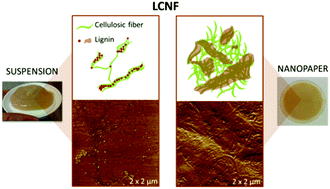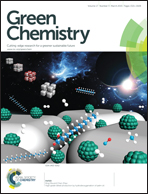Comprehensive elucidation of the effect of residual lignin on the physical, barrier, mechanical and surface properties of nanocellulose films†
Abstract
We elucidate the effect of residual lignin on the interfacial, physical and mechanical properties of lignocellulose nanofibrils (LCNF) and respective nanopapers. Fibers containing ∼0, 2, 4, and 14 wt% residual lignin were microfluidized into LCNF aqueous suspensions and were processed into dry films (nanopapers). A systematic decrease in fibril diameter with increasing residual lignin was observed upon fibrillation, consistent with the radical scavenging ability of the lignin that results in better cell wall deconstruction. The stiff nature of the lignin-containing fibrils made them less able to conform during filtration and improved extensively dewatering, owing to a more open structure. However, the softening of the lignin during hot-pressing of the nanopapers and its amorphous nature enabled a binding effect, filling the voids between the nanofibers (thus reducing the number of micropores) and making the surface of the nanopapers smoother. The interfacial free energy of interaction changed drastically with the increased lignin content: the corresponding water contact angles were 35° and 78° for the lignin-free and for the (14%) lignin-containing nanopaper, respectively, revealing the increase in hydrophobicity. Together with the significantly less porous structure of LCNF nanopapers, lower water absorbency was observed with increased lignin content. Lignin in the nanopapers reduced the oxygen permeability by up to 200-fold. Water vapor permeability, in turn, did not correlate linearly with lignin content but depended most significantly on material density. The tensile strength, modulus, and strain for the LCNF nanopapers were found to be in the range 116–164 MPa, 10.5–14.3 GPa, and 1.7–3.5%, respectively. To a good degree of approximation, these mechanical properties were rather insensitive to lignin content and comparable to those of nanopapers derived from fully bleached CNF. Whilst it might be expected that lignin interferes in hydrogen bonding between fibrils, this was apparently counteracted by the uniform distribution of lignin seemingly aiding stress-transfer between fibrils and thus preserving mechanical properties. Overall, LCNF is demonstrated to be a suitable precursor of nanopaper, especially when reduced polarity and low hydrophilicity are desirable in related bio-products.

- This article is part of the themed collection: 2015 most accessed Green Chemistry articles

 Please wait while we load your content...
Please wait while we load your content...